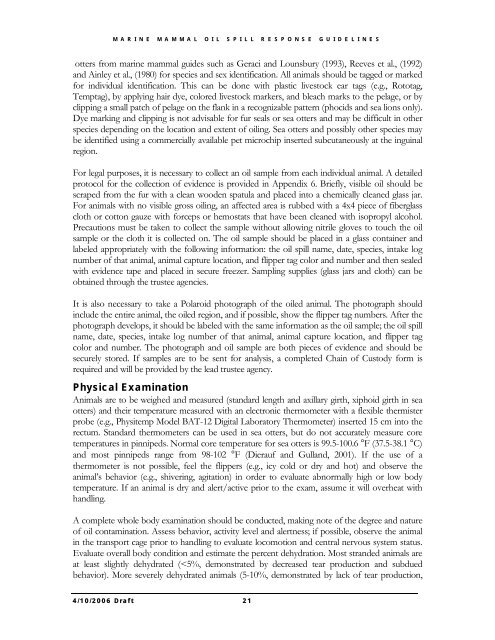Volume III, Appendices EM - National Marine Fisheries Service ...
Volume III, Appendices EM - National Marine Fisheries Service ...
Volume III, Appendices EM - National Marine Fisheries Service ...
You also want an ePaper? Increase the reach of your titles
YUMPU automatically turns print PDFs into web optimized ePapers that Google loves.
MARINE MAMMAL OIL SPILL RESPONSE GUIDELINES<br />
otters from marine mammal guides such as Geraci and Lounsbury (1993), Reeves et al., (1992)<br />
and Ainley et al., (1980) for species and sex identification. All animals should be tagged or marked<br />
for individual identification. This can be done with plastic livestock ear tags (e.g., Rototag,<br />
Temptag), by applying hair dye, colored livestock markers, and bleach marks to the pelage, or by<br />
clipping a small patch of pelage on the flank in a recognizable pattern (phocids and sea lions only).<br />
Dye marking and clipping is not advisable for fur seals or sea otters and may be difficult in other<br />
species depending on the location and extent of oiling. Sea otters and possibly other species may<br />
be identified using a commercially available pet microchip inserted subcutaneously at the inguinal<br />
region.<br />
For legal purposes, it is necessary to collect an oil sample from each individual animal. A detailed<br />
protocol for the collection of evidence is provided in Appendix 6. Briefly, visible oil should be<br />
scraped from the fur with a clean wooden spatula and placed into a chemically cleaned glass jar.<br />
For animals with no visible gross oiling, an affected area is rubbed with a 4x4 piece of fiberglass<br />
cloth or cotton gauze with forceps or hemostats that have been cleaned with isopropyl alcohol.<br />
Precautions must be taken to collect the sample without allowing nitrile gloves to touch the oil<br />
sample or the cloth it is collected on. The oil sample should be placed in a glass container and<br />
labeled appropriately with the following information: the oil spill name, date, species, intake log<br />
number of that animal, animal capture location, and flipper tag color and number and then sealed<br />
with evidence tape and placed in secure freezer. Sampling supplies (glass jars and cloth) can be<br />
obtained through the trustee agencies.<br />
It is also necessary to take a Polaroid photograph of the oiled animal. The photograph should<br />
include the entire animal, the oiled region, and if possible, show the flipper tag numbers. After the<br />
photograph develops, it should be labeled with the same information as the oil sample; the oil spill<br />
name, date, species, intake log number of that animal, animal capture location, and flipper tag<br />
color and number. The photograph and oil sample are both pieces of evidence and should be<br />
securely stored. If samples are to be sent for analysis, a completed Chain of Custody form is<br />
required and will be provided by the lead trustee agency.<br />
Physical Examination<br />
Animals are to be weighed and measured (standard length and axillary girth, xiphoid girth in sea<br />
otters) and their temperature measured with an electronic thermometer with a flexible thermister<br />
probe (e.g., Physitemp Model BAT-12 Digital Laboratory Thermometer) inserted 15 cm into the<br />
rectum. Standard thermometers can be used in sea otters, but do not accurately measure core<br />
temperatures in pinnipeds. Normal core temperature for sea otters is 99.5-100.6 °F (37.5-38.1 °C)<br />
and most pinnipeds range from 98-102 °F (Dierauf and Gulland, 2001). If the use of a<br />
thermometer is not possible, feel the flippers (e.g., icy cold or dry and hot) and observe the<br />
animal’s behavior (e.g., shivering, agitation) in order to evaluate abnormally high or low body<br />
temperature. If an animal is dry and alert/active prior to the exam, assume it will overheat with<br />
handling.<br />
A complete whole body examination should be conducted, making note of the degree and nature<br />
of oil contamination. Assess behavior, activity level and alertness; if possible, observe the animal<br />
in the transport cage prior to handling to evaluate locomotion and central nervous system status.<br />
Evaluate overall body condition and estimate the percent dehydration. Most stranded animals are<br />
at least slightly dehydrated (
















